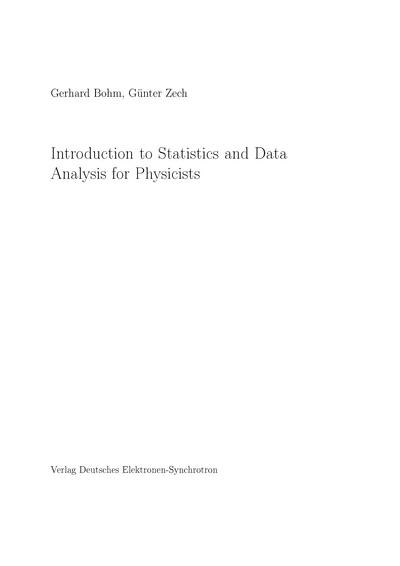
Introduction to Statistics and Data Analysis for Physicists
A free statistic textbook which focuses on modern applications in nuclear and particle physics. Topics include data analysis in modern experiments and likelihood.
Tag(s): Statistics
Publication date: 01 Feb 2010
ISBN-10: n/a
ISBN-13: 978393570241
Paperback: 412 pages
Views: 8,621
Type: Textbook
Publisher: Deutsches Elektronen-Synchrotron
License: n/a
Post time: 22 Oct 2016 01:00:00
Introduction to Statistics and Data Analysis for Physicists
 A free statistic textbook which focuses on modern applications in nuclear and particle physics. Topics include data analysis in modern experiments and likelihood.
A free statistic textbook which focuses on modern applications in nuclear and particle physics. Topics include data analysis in modern experiments and likelihood.
Tag(s):
Statistics
Publication date: 01 Feb 2010
ISBN-10: n/a
ISBN-13: 978393570241
Paperback: 412 pages
Views: 8,621
Document Type: Textbook
Publisher: Deutsches Elektronen-Synchrotron
License: n/a
Post time: 22 Oct 2016 01:00:00
Publication date: 01 Feb 2010
ISBN-10: n/a
ISBN-13: 978393570241
Paperback: 412 pages
Views: 8,621
Document Type: Textbook
Publisher: Deutsches Elektronen-Synchrotron
License: n/a
Post time: 22 Oct 2016 01:00:00
From the Preface:
Bohm and Zech wrote:There is a large number of excellent statistic books. Nevertheless, we think that it is justified to complement them by another textbook with the focus on modern applications in nuclear and particle physics. To this end we have included a large number of related examples and figures in the text. We emphasize less the mathematical foundations but appeal to the intuition of the reader.
Data analysis in modern experiments is unthinkable without simulation techniques. We discuss in some detail how to apply Monte Carlo simulation to parameter estimation, deconvolution, goodness-of-fit tests. We sketch also modern developments like artificial neural nets, bootstrap methods, boosted decision trees and support vector machines.
Likelihood is a central concept of statistical analysis and its foundation is the likelihood principle. We discuss this concept in more detail than usually done in textbooks and base the treatment of inference problems as far as possible on the likelihood function only, as is common in the majority of the nuclear and particle physics community. In this way point and interval estimation, error propagation, combining results, inference of discrete and continuous parameters are consistently treated. We apply Bayesian methods where the likelihood function is not sufficient to proceed to sensible results, for instance in handling systematic errors, deconvolution problems and in some cases when nuisance parameters have to be eliminated, but we avoid improper prior densities. Goodness-of-fit and significance tests, where no likelihood function exists, are based on standard frequentist methods.
Tweet
About The Author(s)
No information is available for this author.
No information is available for this author.
Book Categories
Computer Science
Introduction to Computer Science
Introduction to Computer Programming
Algorithms and Data Structures
Artificial Intelligence
Computer Vision
Machine Learning
Neural Networks
Game Development and Multimedia
Data Communication and Networks
Coding Theory
Computer Security
Information Security
Cryptography
Information Theory
Computer Organization and Architecture
Operating Systems
Image Processing
Parallel Computing
Concurrent Programming
Relational Database
Document-oriented Database
Data Mining
Big Data
Data Science
Digital Libraries
Compiler Design and Construction
Functional Programming
Logic Programming
Object Oriented Programming
Formal Methods
Software Engineering
Agile Software Development
Information Systems
Geographic Information System (GIS)
Mathematics
Mathematics
Algebra
Abstract Algebra
Linear Algebra
Number Theory
Numerical Methods
Precalculus
Calculus
Differential Equations
Category Theory
Proofs
Discrete Mathematics
Theory of Computation
Graph Theory
Real Analysis
Complex Analysis
Probability
Statistics
Game Theory
Queueing Theory
Operations Research
Computer Aided Mathematics
Supporting Fields
Web Design and Development
Mobile App Design and Development
System Administration
Cloud Computing
Electric Circuits
Embedded System
Signal Processing
Integration and Automation
Network Science
Project Management
Operating System
Programming/Scripting
Ada
Assembly
C / C++
Common Lisp
Forth
Java
JavaScript
Lua
Rexx
Microsoft .NET
Perl
PHP
R
Python
Rebol
Ruby
Scheme
Tcl/Tk
Miscellaneous
Sponsors
